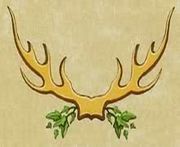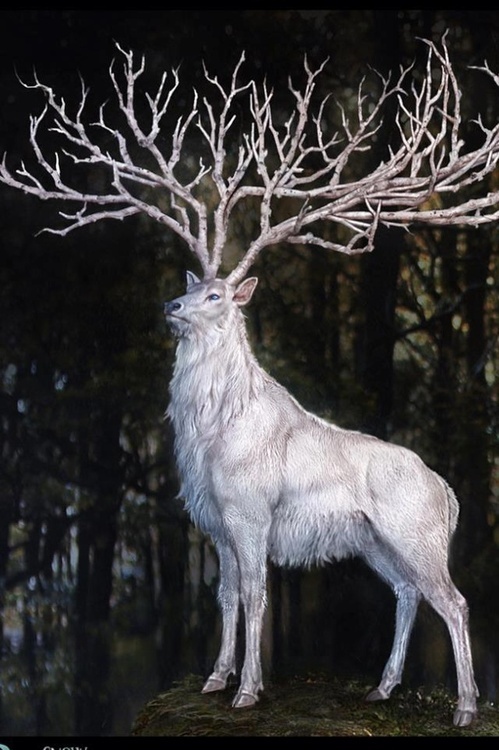The Order of the White Stag
Throughout the Old World, you can find monasteries of the Order of the White Stag, which is the main Monastic Order of the Cult of Taal, the God of the Wild Places and Nature. The Order is famous for the wine and beer which is grown or brewed in the cellars of the Orders monasteries. Although the Order teaches poverty, the monasteries (and their inhabitants) became very powerful. Especially in the countryside monks of Taal are always welcome and treated with great respect. Monks of the Order of the White Stag are recognised by their ordinary brown cowls.
Divine Origins
The Order of the White Stag is possibly one of the oldest monastic communities of the Old World. It was founded nearly 1200 years ago in Tosca, a region in northern Tilea by Francis De la Risibisi.
Francis was the son of a rich and powerful Tilean noble, who owned vast tracks of land. He was the typical young noble: an arrogant, spoiled youngster without any sense of responsibility. The young man was totally selfish, not caring about the common folk. His greatest hobby was hunting.
As often as possible he organised great hunting-parties for his friends, killing the game just for fun. He didn’t care about the warnings of the Taal-priests, who condemned his sins against nature. When a plague broke out in the Tosca, he didn’t care about the sick, their pain amused him. He continued organising his hunting-parties while the poor and sick people were starving.
One day, when he was preparing for yet another hunt an old beggar came to him, asking him for a piece of bread. Francis laughed, spat in the beggar's face and rode away. But this day, Francis was destined to have bad luck while riding through the forest.
While following the tracks of a stag, his horse shied upon the sudden appearance of a snake and threw him. Francis hit with his head on a rock and was knocked unconscious. When he awakened sometime later with a headache, it was night and his horse was missing. He got lost in the dark forest, wandering around the whole night without any idea of where to go. Legend tells that Francis roamed the forests for seven days and seven nights without finding the path home. He was hungry and thirsty and lived like an animal, forgetting about his former pride and arrogance.
In the morning of the seventh day, Francis came to a clearing in the deep forest. In the light of the sunrise there stood a great stag with a perfect white fur. It seemed that the stag shone in a mysterious white light. As Francis stared at the stag he heard a voice in his head say "Francis, I’ve chosen you to be my manservant. From now on you are to wander the world, doing good and teaching my faith.“
Francis asked "Why me?“ and the voice answered "It's your destiny! Follow the stag, it will bring you back to civilisation, where you can begin your work.“ And so Francis followed the stag and came back to the town he lived.
From this day on, Francis was changed. He denied all his wealth and titles, wore nothing more than a brown cowl and sandals and began his work in the name of Taal. He wandered through the Old World and helped the poor and the needy wherever he could. He became famous wherever he appeared. It was said that he was able to speak with animals and that plants grew at his will. He taught, that only those who totally deny wealth and social standing can become totally pure and that money was created by the forces of chaos only to corrupt people.
Soon he had a great number of followers, who lived as he taught them. But the wealthy and powerful church’s authorities became jealous about his success, and they hated his teachings about poverty. When St. Francis arrived at the palace of the Tilean highpriest of the Taal-cult, Cardinal Claudio Porcellino and called on him to deny his wealth in the name of Taal, Porcellino ordered his guards to arrest Risibisi.
Now jailed, Francis knew that only the funeral pile awaited him because the church authorities disliked his teachings. But somehow he managed to escape from the Cardinals jail and fled to the Empire, where the local church’s authorities supported him. Cardinal Porcellino´s hate merely grew even larger as St. Francis became more popular.
Five years after he fled from Tilea, he returned and founded a monastery in Boscoso, a small town in Tosca. Being far too popular now for the Cardinal Porcellino to arrest the corrupt Cardinal made a secret contract with a Skaven grey-seer called Kweebar Longfang: promising that if the Skaven managed to kill Francis then Porcellino would grant them complete freedom of action in the Tosca.
So the cruel conspiracy against Francis began. On a stormy night, Francis was killed by a Clan Eshin assassin. But Porcellinos plan to destroy the Order of Francis failed. Through his death, Francis Risibisi became a martyr and his popularity amongst the people soared to even greater heights. A few days after the saint's death the Cardinal was infected by a horrible disease and died a couple of days later.
The Order of the White Stag grew rapidly spreading out over the whole Old World and the teachings of St. Francis de la Risibisi still live on.
Monasteries dedicate to The Order of the White Stag can be found throughout the Old World the most notable monastic communities are the Convento Boscoso in Tilea (the monastery which was founded by St. Francis himself), the Monastery of La Maisontaal near Frugelhofen in the Borderland in the Grey Mountains between Bretonnia and the Empire and the Monastery in Steinwald in Stirland.
There are also monasteries in Kislev, but they are a little bit different than the other Old Worlder monasteries of the Order, because they belong to the Kislevite Orthodox part of the Church of Taal.
Tenets of Faith
Those men, who want to join the Order of the White stag must be of neutral alignment. When being introduced to the Order they have to take the vows of chastity and if they choose to devote themselves to the service of St. Francis the vow of poverty.
Strictures: The members of the Order have the same strictures as the clerics of Taal as described in the WFRP-Rulebook, page 202.
- Never harm an animal except in self-defence, for food or for sacrifice.
- A sacrifice, of an animal caught by the offerer, must be made to Taal once per month, at the dark of the moon.
- All priests must spend seven days and seven nights each year, starting at the winter solstice, living alone in a wild place, such as a forest or mountain area, communing with nature and living only on what they catch themselves.
- Clerics may not wear metal armour but may use shields and any kind of weapon except firearms and explosives.
Granted Divine Powers
Skills taught in the Monasteries of Taal are of the following: Agriculture, Animal Care, Brewing, Charm Animal, Game Hunting, Herb Lore, Identify Plant, Secret Signs – woodsman. Those who have sworn the vow of poverty also gain the skill begging.
Political Influence & Intrigue
Amongst the common men, especially in the countryside the Orders members are well respected. The townsfolk often look a little suspicious at the monks of the Order.
Sects
There exists a sub-order in the Order of the white Stag whose members totally devote themselves to the teachings of the Founder of the Order: St. Francis de la Risibisi. They are called 'Franciscans'. There is no difference between the Franciscans and the ordinary members of the Order only that the first take additional the vow of poverty.

The main Monastic Order of the Cult of Taal
Type
Religious, Cult



Comments